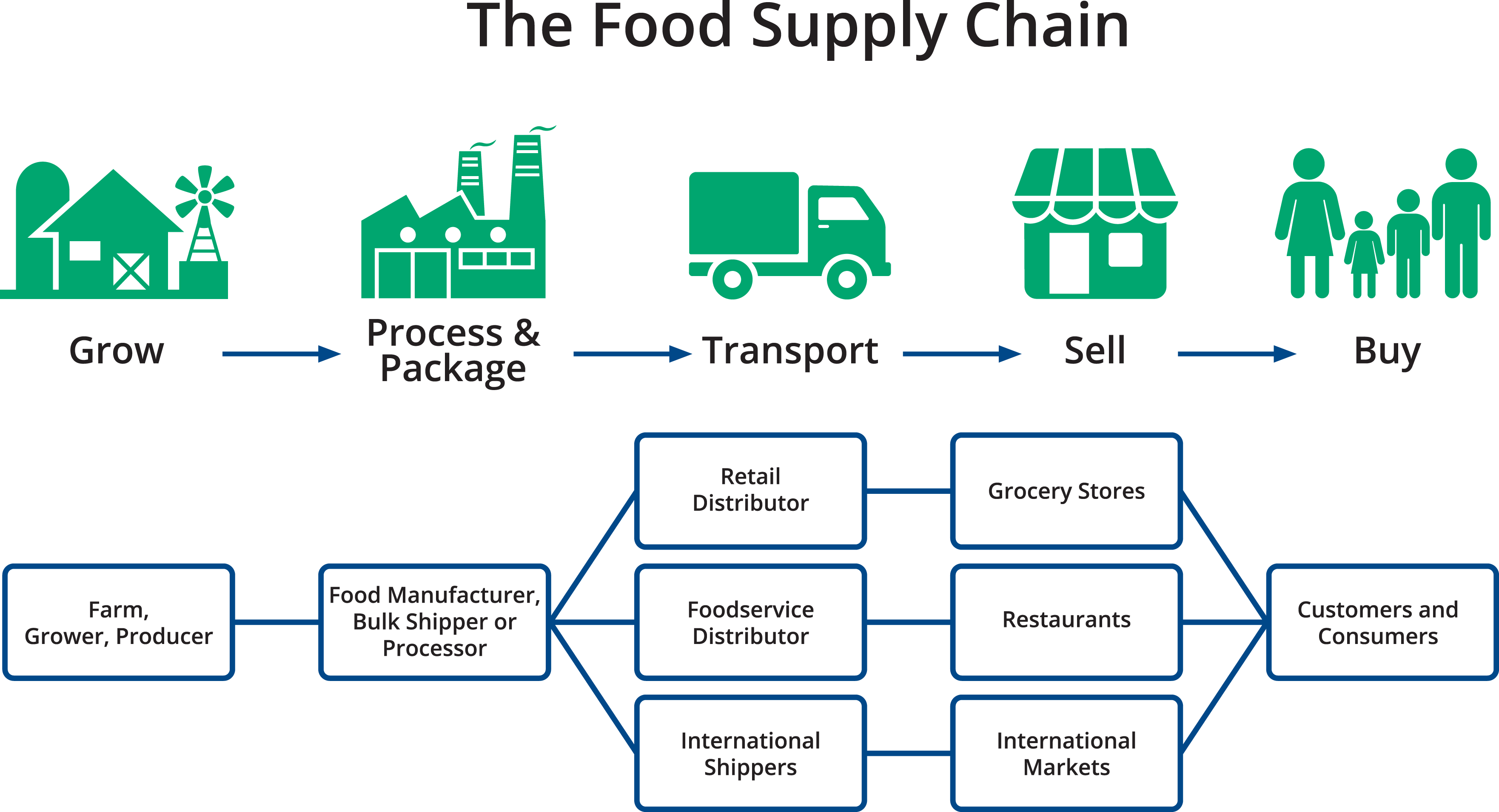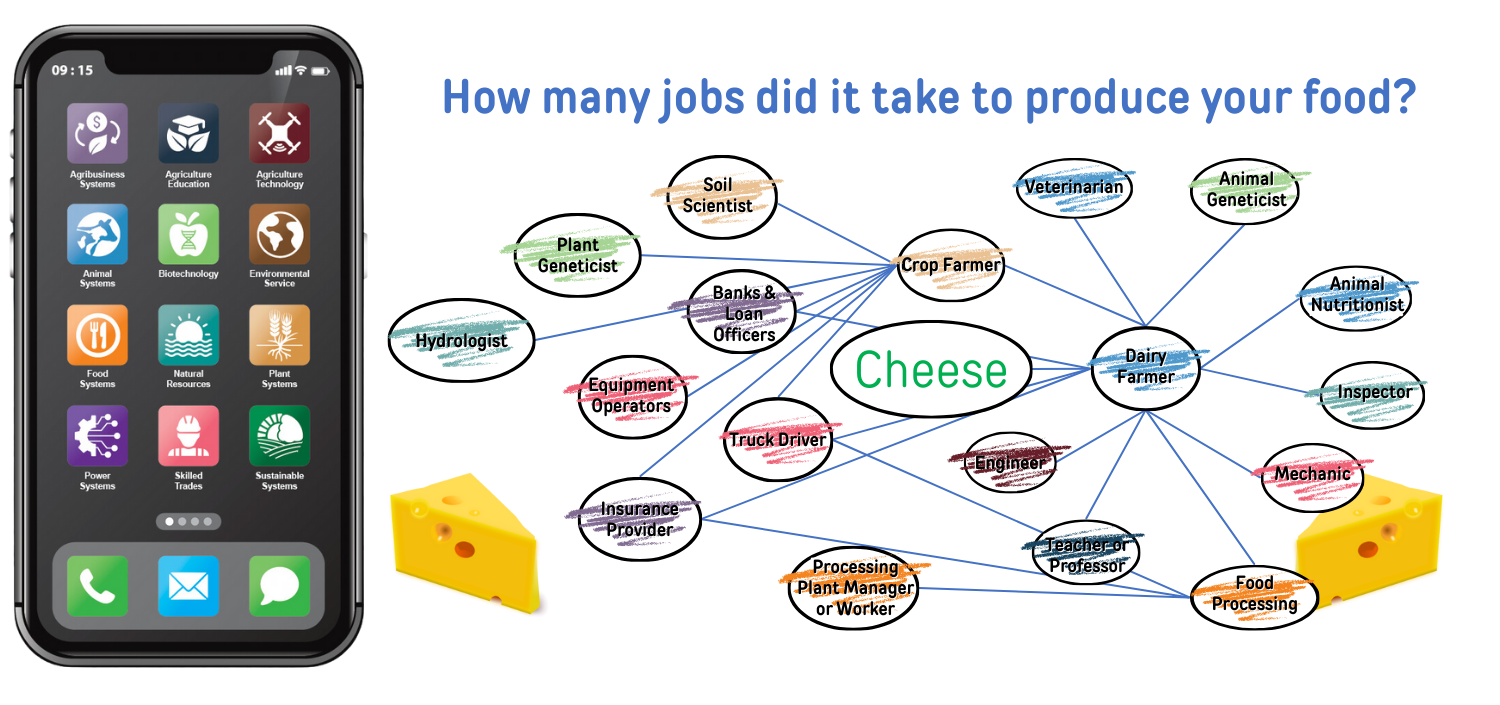Agricultural Literacy Curriculum Matrix
Lesson Plan
Career Trek: From Farm-to-Fork
Grade Level
6 - 8
Purpose
Explore the farm-to-fork process of food through the lens of careers. Students will make a career web to see the variety of careers and skill sets necessary to our food system. They will check their understanding by playing Career Trek—a board game that requires students to identify careers in agriculture and natural resources. Grades 6-8
Estimated Time
60-90 minutes
Materials Needed
Activity 1: Agriculture is a Source for Careers
- Example Career Web (for reference)
- Discover Agriculture poster (to project digitally)
- Large paper (section of butcher paper, 11"x17" ledger, etc.), 1 per group
- Markers or colored pencils
Activity 2: Discover Careers in Agriculture
- Student access to the Discover Agriculture Careers website
- Blank sheet of paper and markers or colored pencils
Evaluation
- Career Trek game board, 1 for every 4 students
- Dice, 1 per group
- Game pieces (beans or tokens), 6 per student
Vocabulary
career: an occupation undertaken for a significant period of a person's life and with opportunities for progress; generally a profession requiring special training
Did You Know?
- Only 10% of Americans are involved in a career in traditional farming or ranching.1
- Agriculture careers include those in business, building, agriscience, horticulture, forestry, food science, wildlife, and more.1
- Approximately 22 million people work in agriculture-related fields. 1
Background Agricultural Connections
Considering a career in agriculture and natural resources? Can you name ten careers in these fields? Careers in agriculture and natural resources provide people with the things they use every day: food, clothing, and shelter. Farmers and ranchers work with a multitude of scientists, technicians, business people, and educators to produce safe, inexpensive food. Researchers and scientists help to develop new seeds, safer crop protection, and more efficient machines that are part of a large, complex system that provides us with the things we use every day. Opportunities have expanded in the field of agriculture to include unique positions in sustainable farm management systems, biotechnology, forestry, marketing, engineering, and more.
The farm-to-fork path of food supports a vast number of jobs across multiple stages of the supply chain, reflecting the complexity of bringing food from fields to tables. At the production level, roles include farmers, ranchers, agricultural laborers, and equipment operators who grow and harvest crops or raise livestock. The processing and manufacturing stage employs food scientists, quality control specialists, and factory workers to transform raw products into consumable goods. Logistics and distribution provide opportunities for truck drivers, warehouse operators, and supply chain managers to ensure timely delivery to markets. In retail and hospitality, grocery store employees, chefs, restaurant staff, and food service managers play crucial roles in making food accessible to consumers. Additionally, professionals in marketing, sustainability, and regulatory compliance contribute to maintaining a transparent and efficient system, making the farm-to-fork pathway a major source of employment worldwide.
Careers in agriculture and natural resources have a wide range of education requirements, reflecting the sector’s diversity. Entry-level positions, such as farm laborers, equipment operators, or forestry technicians, may require only a high school diploma and on-the-job training. More specialized roles, like agricultural technicians, conservationists, or animal husbandry experts, often call for associate or bachelor’s degrees in fields such as agronomy, environmental science, or animal science. Advanced positions in research, policy, or technology development, such as agricultural engineers, soil scientists, or wildlife biologists, typically require graduate-level education, including master’s or doctoral degrees. Certifications and vocational training programs also provide pathways for roles in areas like pesticide application, irrigation management, or sustainable farming practices, making education in this field adaptable to a variety of interests and career goals.
Engage
- Ask students what they have eaten in the last 24 hours. Make a list of the common food items eaten by the students. Write the list on the board.
- Once the list has been made, choose several random foods and ask the students where or how that item was originally produced. For example, where did the egg they ate for breakfast come from? How did it get from the farm to the grocery store? Allow students to offer their prior knowledge as you discuss these items.
- As they start thinking about the source of each food item, have them also think of all the careers that played a role in getting the food from the farm to their plate. If your students need more background knowledge to be successful, project the Food Supply Chain graphic and go through the steps.

Explore and Explain
Activity 1: Agriculture is a Source for Careers
- Help students see that agriculture is not only the source of most all of the items we need and use every day, but also the source of many careers. Ask students the following series of questions:
- What is the primary ingredient of cheese? (milk)
- What kind of farm is milk produced on? (dairy farm)
- Beginning on a dairy farm where the milk is produced and ending at your home where cheese is consumed, how many careers played a role in providing cheese for us to eat? (allow students time to begin thinking about the answer to this question.)
- Begin drawing a career web (example below) on the board. Explain that there is an interconnected web of careers that depend upon each other to produce the food we eat. Using the notes below, briefly describe how these careers are connected to the dairy farm and are necessary to produce the milk that is used to make cheese. Be sure to also explain that the web could be much larger. This is only a small sample.
- Dairy Farmers: Raise and care for cattle on farms where milk is produced.
- Veterinarians: Assist farmers in maintaining the health and well-being of animals.
- Animal Geneticists: Research how genetic traits impact the health and productivity of animals and help farmers make the best decisions regarding the genetics and breeding of their animals.
- Animal Nutritionists: Formulate the diets of animals to meet their nutritional needs. Nutritionists help dairy farmers provide a healthy diet for their cattle at each stage of their lives.
- Inspectors: Monitor the transportation of livestock animals and verify livestock ownership.
- Salesmen: Help in many areas of agriculture by providing the right kinds of tools and equipment to accomplish a variety of jobs.
- Crop Farmers: Produce feed for dairy farmers, such as corn, alfalfa, soybeans, etc.
- Soil Scientists/Agronomists: Analyze the quality of soil and help farmers balance the nutrients to enable the growth of healthy crops.
- Plant Geneticists: Study the genetic traits of plants and use methods of crossbreeding and hybridization to perpetuate desirable traits in plants.
- Feed or Seed Store Managers: Provide farmers with access to the feed, seeds, and other farm supplies necessary to their farms.
- Truck Drivers: Transport agricultural goods from production to processing and then to be distributed to consumers.
- Engineers: Design new technology to improve productivity and sustainability (for example, automated sprinkler systems, robotic milking equipment, etc.).
- Food Scientists: Study the science of food preparation and formulate recipes (for example, developing different types of cheese-making methods).
- Mechanics: Repair and maintain equipment such as trucks, tractors, and farming implements.
- Divide students into teams or small groups and assign them one food. Give each group one large sheet of paper (a section of butcher paper, 11"x17" ledger paper, etc.) and markers.
- Ask students to create a career web for the food item they were assigned.
- Once the web is complete, students should color code each career in the pathway it matches best (as seen on the poster). You can project the Discover Agriculture poster for guidance.
- Ask students questions to help them reflect on the activity:
- Are there more or less jobs involved in producing our food than you would have guessed?
- Are the jobs on the web similar or different? Do they fit in the common assumptions of an agricultural career? Are they all located on the farm?
- Do all the jobs require a college education?

Activity 2: Discover Careers in Agriculture
- Give each student or group of students a blank sheet of paper and colored pencils or markers. This activity can be completed individually or in groups of two.
- Each student or group of students should navigate to the Discover Agriculture Careers website and begin exploring careers in agriculture by clicking on each agricultural career pathway. They should create a word cloud and/or picture collage that would represent the variety of careers they find in the agriculture and natural resource sectors.
- Option: Your students can also make the word cloud digitally using Canva or other similar software.
- Option: If you need an option without internet/computer use, get a set of career cards or the Discover Agriculture Careers Resource Bundle from agclassroomstore.com for a hands-on activity.
Elaborate
Have students visit the My Next Move website and complete the o-net Interest Profiler. This tool can help students identify how their interests can relate to the world of work.
Evaluate
Career Trek
- Divide the class into groups of 2-4. Each group will need a Career Trek Game board, one dice, and small game pieces like beans or tokens (6 per person).
- Instruct students to read the game instructions found on the board and proceed to play the game. The game is designed to assess basic student knowledge about agricultural and natural resource careers. The game includes a list of 32 careers. Clarify to students that it is permissible to mention agricultural and natural resource careers that have been discussed in class but are not on the game board (the group needs to agree that the occupation stated is an agricultural or natural resource career, like agreeing on a word in Scrabble). When all students can name at least 10 agricultural and natural resource careers, they have met the core objectives.

- After conducting these activities, review and summarize the following key concepts:
- Careers in production agriculture include farmers and ranchers. Typically, these careers are directly involved with the growing of crops or the raising of animals.
- In addition to production agriculture, there are many careers in fields related to agriculture such as business, science, nutrition, and more.
Recommended Companion Resources
- Careers in Agriculture
- Careers 101 e-Magazine
- Careers Ag Mag
- Discover Agriculture Careers Resource Kit
- Connecting to Agriculture
- Field to Film Career Snapshots
- Ag & Food Careers
- Corteva Grows Science: Outreach Career Paths
- Employment Opportunities for College Graduates in Food, Renewable Energy, and the Environment
- Pathful Connect
Author
Andrea Gardner
Organization
National Center for Agricultural Literacy (NCAL)
| We welcome your feedback! If you have a question about this lesson or would like to report a broken link, please send us an email at matrixelearning@gmail.com. If you have used this lesson and are willing to share your experience, we will provide you with a coupon code for 10% off your next purchase at AgClassroomStore. |
